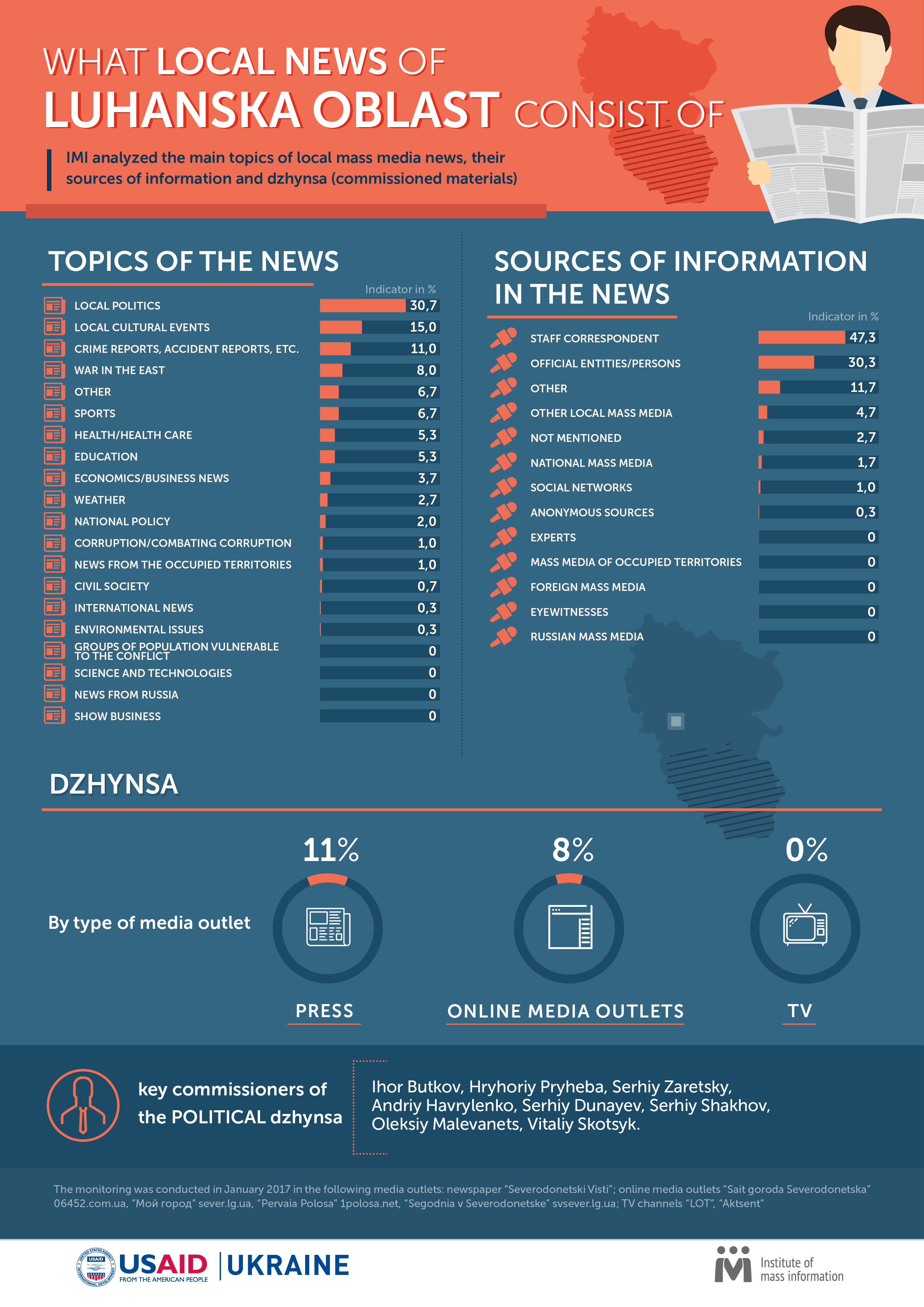For almost three years, Luhanska oblast has been in the zone where the Anti-Terrorist Operation is being conducted. Since 2014, Severodonetsk became the oblast and administrative center of the part of Luhanska oblast controlled by the Ukrainian authorities. Correspondingly, this city now hosts oblast media outlets, which previously had their central offices in the occupied Luhansk.
Since 2014, a considerable part of Luhansk mass media ceased to function. The occupation of the city most seriously hit newspapers, the great majority of which closed down. Of three Luhansk oblast TV channels, two managed to resume broadcasting from Severodonetsk: Luhansk oblast state TV and Radio Company and the independent TV and Radio Company «Irta» belonging to the former MP from the Party of Regions Volodymyr Landyk. The oblast association «Luhansk Cable Television» stayed in Luhansk.
Almost all online media outlets, which after the beginning of the hybrid war assumed a pro-Ukrainian stance, continue to function. At that, not all journalists of online resources covering the events of the Easternmost oblast of Ukraine live in Severodonetsk and other cities of Luhanska oblast. Many of them settled in other regions, including Western Ukraine, and are working remotely.
Presently, in Luhanska oblast about one hundred media outlets of various types are functioning. Still, only 15-20 per cent of them can be characterized as noticeable and influential.
Other broadcasting TV channels, in addition to the above-mentioned Luhansk Oblast State TV and Radio Company and «Irta», there is the Lysychansk-based TV Channel «Aktsent», which belongs to Lysychansk city council and is controlled by the former mayor of Lysychansk, presently MP from the «Opposition Bloc» Serhiy Dunayev, LLC «Energy Investment company», and Severodonetsk TV Channel STV, which in fact does not have its own broadcasting and covers the city of Severodonetsk and the radius of 50-70 km around it (Rubizhne, Lysychansk, Popasnianskyi and Novo-Aidarivskyi rayons).
In the last years, in Severodonetsk only one weekly newspaper is printed regularly: «Severodonetski Visti», founded by the local city council. In 2015, in the city a new newspaper emerged — «Visnyk Luhanshchyny», founded by the department of mass communications of Luhansk oblast state administration. Yet, it is not published every week. At the website of Luhansk oblast state administration, the first issue of this periodical for 2017 appeared only as of February 8. In addition, «Visnyk Luhanshchyny» is not available to the general public.
In Severodonetsk, private newspapers are issued from time to time. For example, «Trybun» owned by the former head of the mass communications department of Luhansk oblast state administration Denys Denyshchenko, who at the time of the local elections of 2015 ran the oblast elections headquarters for the party « Petro Poroshenko’s Bloc “Solidarnist”». The last special issue of this newspaper is dated as of July, 2016.
Online media outlets, which regularly offer information about Luhanska oblast, can be divided into three categories.
The first category includes editorial offices, which have their headquarters in Kyiv or in other cities, yet they have their websites informing about the events in Luhanska oblast. These are «Depo. Donbas», «Komentari. Donbas», Luhansk newsfeed «Ostrova», and the website of Severodonetsk city «06452».
The second category is the media outlets that had their headquarters in Luhansk before 2014, yet were forced to move out, and after moving they settled in Severodonetsk or in neighboring cities. They are «Skhid Media», controlled by vice-mayor of Severodonetsk, representative of the Radical Party of Oleh Liashko, Hryhoriy Pryheba; «Irta-FAX», financed by Volodymyr Landyk; «Trybun», affiliated with Denys Denyshchenko; «Paralel'-Media», which was financed by Vadym Daniyelian, a politician from Luhansk, who until recently was the head of the Service of Automotive Highways of Luhanska oblast, and in the beginning of 2017 became the vice-head of Luhanska Oblast Military and Civil Administration.
The third group is local online media outlets, some of which had to leave Severodonetsk for a short period, after it was captured by pro-Russian militants in 2014, yet they returned in the same year, when the city was liberated by the Ukrainian troops. This group includes «Severodonetskiye Strasti», which is affiliated with the member of Severodonetsk city council from «Petro Poroshenko’s Bloc» Serhiy Samarskyi, «Pervaya Polosa», which regularly publishes promotional materials for Serhiy Dunayev and the acting city mayor of Severodonetsk from the «Opposition Bloc» Ihor Butkov, «Segodnia v Severodonetske», which mainly publishes the head of Luhansk branch for the all-Ukrainian NGO «Committee of voters of Ukraine», Oleksiy Svetikov, and «Moy Gorod».
For a long time, Russian was the dominating language in local media outlets. Yet, now we can observe diminishing presence of Russian while the presence of Ukrainian increases. One can hear more Ukrainian on TV channels and on the radio. The online media outlet «Paralel'-Media» almost completely transited from Russian into Ukrainian.
In Severodonetsk, the relations between the native journalists and the journalists who relocated from Luhansk feel quite strained.
In January of this year, Luhansk Oblast State TV and Radio Company published a story about a pregnant IDP, whom the doctor refused to see for not leaving her overcoat in the coatroom. This material was criticized by the Severodonetsk resident Oleksiy Svetikov. At the website «Segodnia v Severodonetske,» he expressed an opinion that «it is far from being the first time when Luhansk journalists soil the name of Severodonetsk doctors using ridiculous excuses», and finished his material with the following words:
«Dear Luhansk residents! We people from Severodonetsk are not the ones to blame for the fact that you had to, following your employers, move from Luhansk, which is almost the capital, to provincial Severodonetsk. I am sure that the great majority of you will soon return to your governor's seat city. Yet for now, be so kind, be patient with us. With our people, with our infrastructure, our refugee hostel rules. Severodonetsk secures and will secure the displaced people who live here with the conditions that local residents live in. The schools and pre-school facilities of Severodonetsk, hospitals, cultural institution — they are all yours. Just be so kind, follow the rules established in these facilities. Just like local residents do».
Topics of news in local media
Based on the results of the monitoring of media outlets, as to the share of covered events related to local politics, Severodonetsk turned out to be the leader— 31% from the total number of materials. The information on this topic is mostly published by the Severodonetsk newspapers and online media outlets (33% each). TV, however, is not far behind — 26%.
In the beginning of 2017, on the territory of Luhanska oblast controlled by Ukraine, quite many cultural events were conducted, so it is not a surprise that reports about them comprised 15% of publications. Such materials comprised 22% in printed media outlets, 16% on TV, and 7% – in online media outlets.
It is difficult to tell the reason for sure – whether it was due to a large number of report-worthy events, crimes, and traffic accidents in Luhanska oblast, or due to overzealous (or, perhaps, just thorough) work of press services of law enforcement agencies and departments for emergencies – but, whatever the reason, the percentage of such reports is 11%. Online media outlets report about crimes and other emergencies most often (22%), TV channels follow suit (11%), but newspapers decided to skip such reports entirely.
In the last year, the media outlets of Luhanska oblast started to report about the events at war more often. The percentage of such news increased from 5 to 8%, and became one of the highest compared to other regions. The leaders with most stories about the war are the websites «06452», «Moi Gorod», «Segodnia v Severodonetske» and Luhansk Oblast State TV and Radio Company. Unlike them, the newspaper «Severodonetski visti», the online media outlet «Pervaya Polosa,» and the TV channel «Aktsent» did not publish anything about events in the hot zones of Luhanska oblast, despite the fact that their editorial offices are just mere dozens kilometers away from the front line.
The media outlets of Luhansk region did not report anything about international news at all; also, they never published any stories related to environmental protection, news from Russia, show business, science and technologies, or the groups of population affected by the conflict.
Covert advertisement in local media
Mass media of Luhanska oblast, which have to work in the conditions of the consistently plummeting advertisement market, do not turn away proposals to publish materials that are likely dzhynsa (covertly commissioned advertisement). The overall indicator of such publications in the media outlets of Severodonetsk is 6%. In newspapers, it was equal to 11%, in online media outlets — 8%, yet in the period of the monitoring, dzhynsa was never broadcast on the local TV channels.
Most materials, published in local media outlets that are likely dzhynsa, were related to the acting mayor of Severodonetsk, the secretary of the city council Ihor Butkov, and deputies of the Severodonetsk city mayor – Hryhoriy Pryheba, Serhiy Zaretskyi, and Andriy Havrylenko. The next were Serhiy Dunaev and the People’s Deputy of Ukraine Serhiy Shakhov, a former member of Severodonetsk city council from «Nash Krai». Representatives of the Agrarian party were also using commissioned materials to advertise themselves.
Sources of information for local media
The media outlets of Severodonetsk have one of the highest of Ukraine rates of using information from their own correspondents — 47%. Most reliant on their own sources are TV channels — 82%; for the newspapers, this indicator was equal to 50%, and for online media outlets – only 10%.
Local media outlets often use data provided to them by the official structures — 30%. Online media outlets also like to quote this source of information — 48%, as do newspapers — 33%; yet, TV channels mention the official sources comparatively infrequently — 10%.
Mass media also use materials from their colleagues. Most often, this source is used by the journalist of online media outlets — 14%, unlike printed media outlets and TV, where this indicator is equal to 0%.
The media outlets of Severodonetsk never refer to Russian and other foreign colleagues, experts, eyewitnesses, and anonymous sources.
In local media outlets, there are in fact no serious investigations about corruption or about war crimes. This is because there are almost no experienced journalists left in the region. Most of them left Luhanska oblast and, most likely, will never return.
The monitoring was conducted by the in January 2017 in the following media outlets: the newspaper «Severodonetski visti» (number of copies 4,500, weekly); the online media outlet 06452.com.ua (approx. 938 unique visitors per day), Sever.lg.ua (approx. 6159 unique visitors per day), 1polosa.net (no counters), Svsever.lg.ua (no counters); the TV channel «LOT», «Aktsent».
The monitoring was conducted by the experts of the Institute of Mass Information with the support of the Ukraine Confidence Building Initiative (UCBI), funded by the United States Agency for International Development (USAID).
The methodology is explained in more detail on the IMI website.





